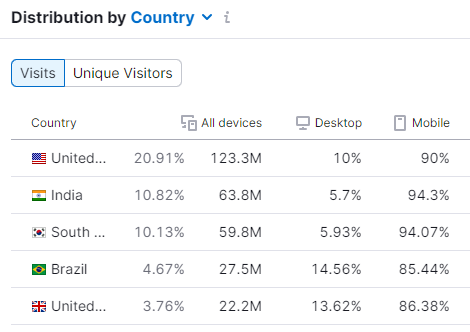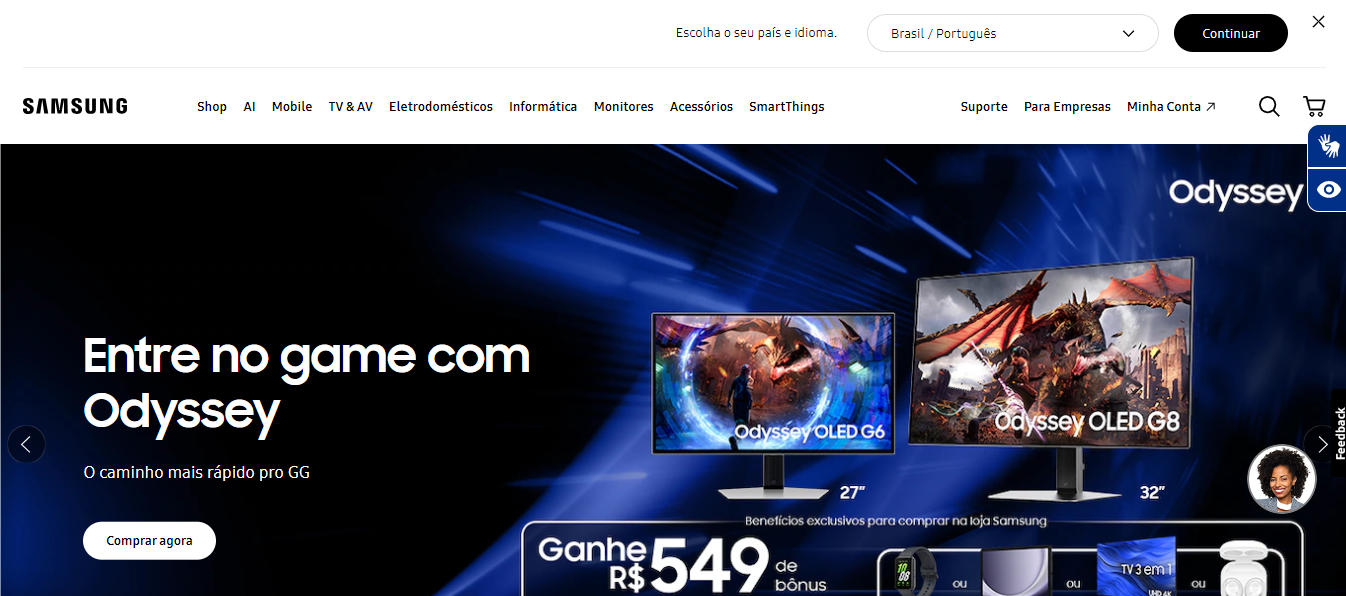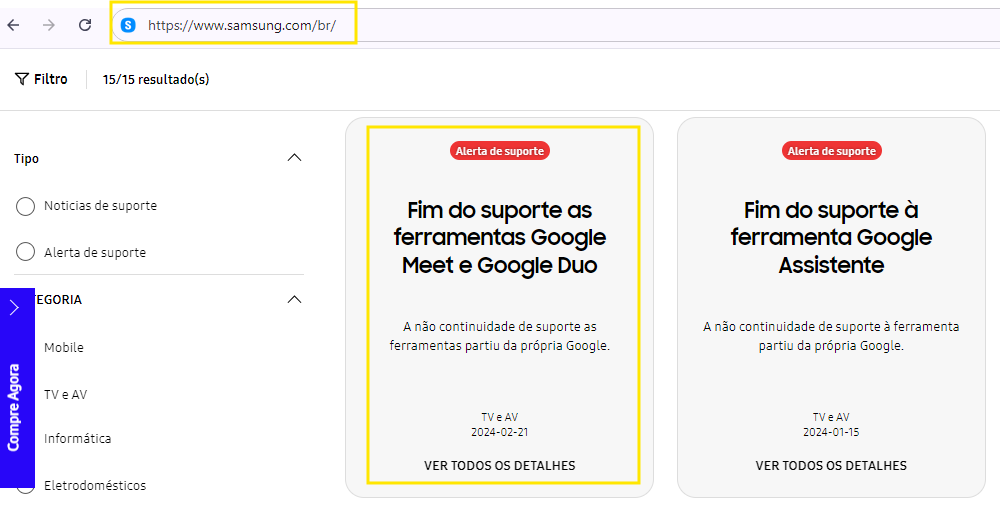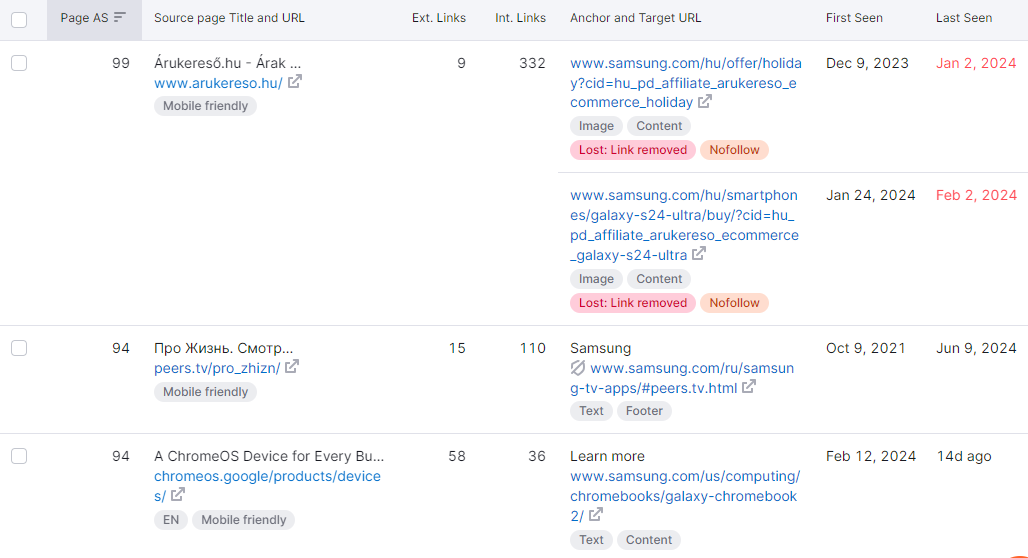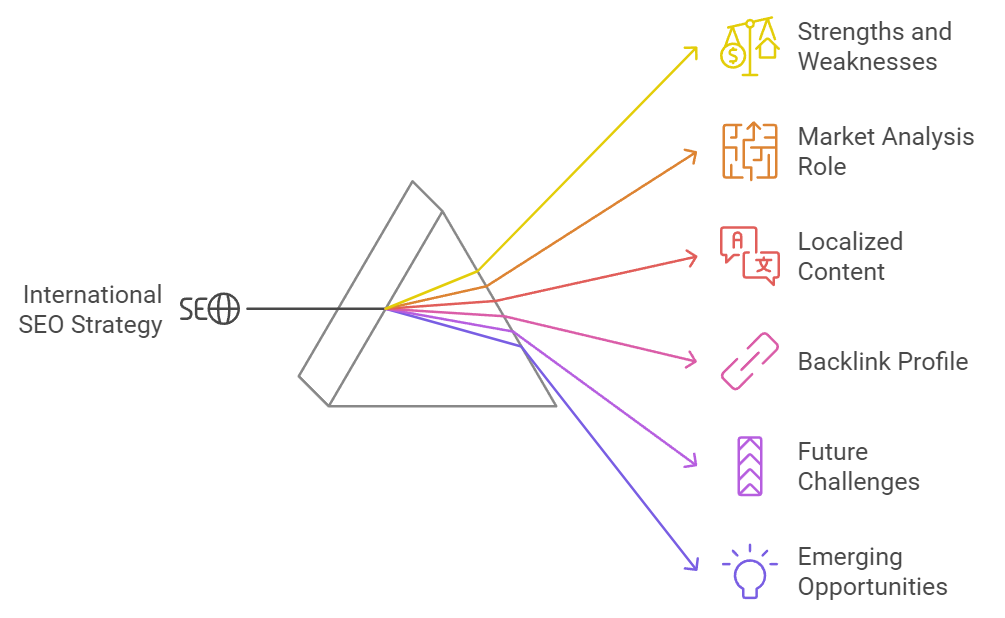Listen to this story
Brief Overview of Samsung
Samsung, a South Korean multinational, is synonymous with cutting-edge technology. It reigns supreme as the world’s largest manufacturer of smartphones and memory chips, but its influence extends far beyond that.
Samsung offers many products, including televisions, home appliances, and more, solidifying its position as a global leader in the electronics industry.
Samsung leverages a robust international SEO strategy to maintain its dominance. This strategy ensures Samsung’s websites rank well in search results worldwide.
Samsung targets the needs and interests of various regions by delivering content and frequently used keywords according to the region and language. This meticulous approach allows them to capture market share in new territories, increase brand awareness, and drive global sales.
Why Samsung Needed International SEO
Despite its brand recognition, Samsung still needs a strong international SEO strategy for several reasons:
Market Specificity: User search preferences and competition vary significantly across countries. International SEO tailors content and strategy to rank well in each target market.
Local Language Optimisation: Reaching local audiences requires websites in their native languages. SEO ensures these localised sites rank well in local search results.
Mobile Dominance: With mobile internet usage on the rise globally, optimising for mobile search is crucial. International SEO ensures Samsung’s websites are mobile-friendly across devices and regions.
Increased Brand Awareness: A strong international SEO strategy improves Samsung’s online visibility in new markets, driving brand awareness and potential sales.
Segregation of Country Share behind Samsung International SEO strategy
Samsung’s international SEO strategy likely involves a tailored approach for each target market:
Domain Strategy: Choose the right domain strategy (subdomains, subfolders, or ccTLDs) based on the target market’s preferences. For example, Yandex favours ru ccTLDs in Russian-speaking countries.
Local Hosting: Considering requirements like local hosting is essential for Baidu in China.
Market Analysis: Understanding the ‘market share’ of specific keywords in each target market to align the SEO strategy with the local digital landscape.
By adopting these strategies, Samsung can improve its search engine rankings in various countries and increase direct customer interactions, gathering valuable data to enhance its online presence further.
How Samsung Implemented International SEO
Samsung’s implementation of International SEO is a comprehensive strategy tailored to suit diverse global markets. The company recognised that a localised approach was key to success. Here’s an overview of their implementation:
Localised Content: Samsung created localised content, ensuring translations were literal, culturally relevant, and optimised for the target market. This included adapting keywords and terminology to align with local search trends and user queries.
Market-Specific Websites: They employed a thoughtful domain strategy, utilising country-specific domains (e.g., ccTLDs like .de for Germany) and subdomains/subfolders to cater to specific markets. This approach helps search engines understand the website’s target audience and improves local rankings.
Local Hosting: Samsung adopted local hosting solutions, ensuring faster loading times and improved user experience. This is critical for search engines like Baidu in China, which prioritise locally hosted websites.
Market Analysis: Each market’s unique characteristics were thoroughly analysed. This included understanding local competitors, popular search engines, and the market share of specific keywords. This insight guided Samsung’s strategy, ensuring it resonated with local users and search platforms.
Backlink Strategies: Building backlinks from reputable, locally relevant websites was likely a key part of Samsung’s strategy. This helps establish authority and trust with local search engines, improving the company’s overall SEO performance.
Continuous Optimization: Samsung likely employs ongoing optimisation, regularly analysing search performance and user behaviour data to refine its SEO approach. This agile methodology ensures Samsung’s online presence remains relevant and effective in the dynamic digital landscape.
Samsung Key Markets
Samsung’s website structure for its key markets (US, UK, Brazil, Germany, India) appears well-optimized for international SEO. It uses a consistent subfolder structure with clear country codes.
Technical SEO
Secure Protocol (HTTPS): Samsung’s use of HTTPS (seen in the Brazilian URL) ensures secure connections and protects user data. This is now standard practice and is favoured by search engines, often providing a minor ranking boost.
Consistent Structure: The URL structure across different markets maintains consistency, making it easier for search engines to crawl and index the websites. This consistency also aids internal linking and ensures a seamless user experience when navigating markets.
Samsung’s technical SEO strategy for its key markets is well-executed, focusing on localised content, user-friendly URL structures, and adherence to technical best practices.
This approach improves search engine visibility and enhances the overall user experience, ultimately supporting Samsung’s global online presence.
URL Structure
- The use of subfolders (e.g., /us/, /uk/, /br/, etc.) indicates a thoughtful approach to organising content for different markets while maintaining the authority of the main domain (www.samsung.com).
- By employing this structure, Samsung can effectively target specific countries, as search engines understand the intended audience for each subfolder.
- This strategy also simplifies the management of multiple markets from a single domain, making it easier to implement global changes if needed.
| Country | URL Structure |
| US | www.samsung.com/us/ |
| UK | www.samsung.com/uk/ |
| Brazil | https://www.samsung.com/br/ |
| Germany | www.samsung.com/de/ |
| India | www.samsung.com/in/ |
Content Localization
Localised content is crucial for user engagement and search engine optimization. By providing content in the local language, Samsung improves user experience and increases the likelihood of users finding the website through local search queries.
Translated content
Samsung ensures that content is translated and localised for each market, as evidenced by using different languages (English, German, Portuguese, etc.).
Using translated keywords and optimised terminology further enhances the effectiveness of Samsung’s content localisation strategy, ensuring that the website resonates with local audiences and aligns with their search behaviours.
Localised Content
Localised content is a pivotal aspect of Samsung’s international SEO strategy, and it involves tailoring content to specific local markets in terms of language, culture, and user behaviour. Here’s an overview:
Language Translation: Samsung ensures that content is translated into the local language of each target market. This is essential for user engagement and search engine optimisation. By presenting content in the user’s native language, Samsung makes its products and services more accessible and relatable.
Cultural Relevance: Localization goes beyond mere translation. Samsung adapts its content to ensure cultural relevance. This includes considering local customs, traditions, and values and avoiding potential cultural pitfalls. By aligning with local cultural nuances, Samsung demonstrates a deeper understanding of its diverse customer base.
Optimised Keywords: Localized content optimisation involves extensive keyword research for each market. Samsung identifies keywords and search terms that users in a specific region will likely use. By incorporating these localised keywords, Samsung ensures its content aligns with local search trends and improves visibility on search engine results pages.
Market-Specific Examples: To enhance user engagement, Samsung may include market-specific examples, references, and case studies in its localised content. This could involve featuring local influencers or showcasing products in a context familiar to local users, making the content more relatable and impactful.
Local Regulations and Compliance: Samsung also considers legal and regulatory requirements when localising content. This includes adhering to local data privacy laws, ensuring that terms and conditions are translated accurately, and providing region-specific product information to comply with local standards.
Traffic Numbers by Countries Subfolders (Worldwide)
The traffic data reveals some interesting insights:
US Dominance: The US website boasts the highest traffic (20.7M), indicating a strong presence in the American market.
Brazil’s Potential: Brazil follows closely with 18.3M visitors, suggesting significant potential for further growth.
Room for Improvement in Europe: The UK and Germany show considerably lower traffic (834.9K and 845.5K respectively). This suggests opportunities for Samsung to improve its SEO strategy in these European markets.
| Country | Traffic | Subfolders |
| US | 20.7M | www.samsung.com/us/ |
| UK | 834.9K | www.samsung.com/uk/ |
| Brazil | 18.3M | https://www.samsung.com/br/ |
| Germany | 845.5K | www.samsung.com/de/ |
Keywords Numbers by Countries Subfolders (Worldwide)
The keyword data paints a slightly different picture:
Germany’s Keyword Focus: Germany leads in keyword count (9.2M) despite having lower traffic than Brazil (935.1K). This could indicate a broader keyword targeting approach in Germany or a need for content optimisation in Brazil to match user search intent better.
US Keyword Efficiency: With 4.6M keywords and the highest traffic, the US might strike a good balance between keyword targeting and attracting relevant visitors.
UK Keyword Strategy: The UK’s keyword count (6.8M) falls between the US and Germany, but further analysis is needed to understand its effectiveness compared to traffic.
| Country | Keywords | Subfolders |
| US | 4.6M | www.samsung.com/us/ |
| UK | 6.8M | www.samsung.com/uk/ |
| Brazil | 935.1K | https://www.samsung.com/br/ |
| Germany | 9.2M | www.samsung.com/de/ |
Backlink Profile for Local Language Content/Subfolder
Quality and Quantity: A strong backlink profile with high-quality links from relevant Brazilian websites significantly improves search ranking in local search results.
Local SEO Effectiveness: By analysing the backlink profile, we can assess how well Samsung’s Brazilian subfolder is positioned for local SEO compared to competitors.
Sub Domain: www.samsung.com/br/
Top Backlinks for Subfolder
- Getting backlinks within the same geographical region and language
- Analysing keyword data alongside traffic can reveal opportunities to optimise content for user search intent in each market.
- Backlink analysis of each country’s subfolder would provide further insights into local SEO effectiveness.
Top Countries for Backlinks
- The two major countries for backlinks (root domain) are the US and Germany.
- The United States is the leading country for backlinks to Samsung’s root domain, with 79% of all backlinks. This suggests that Samsung has a strong focus on SEO in the US market and has likely built backlinks from high-authority websites in the US.
- Germany is the second-largest country for backlinks, with 9% of all backlinks. This indicates that Samsung also prioritises SEO in Germany but to a lesser extent than the US.
- The remaining 12% of backlinks come from all other countries. This suggests that Samsung may benefit from a more global SEO strategy, focusing on building backlinks from high-authority websites in other key markets.
In-Depth Analysis of Samsung’s International SEO Strategy
1. Strengths and Weaknesses
Samsung’s international SEO strategy showcases strengths in localized content and regional SEO tactics, such as dedicated country-specific websites. However, a notable weakness is the underutilization of local search trends in European markets. Enhancing SEO practices here could significantly boost visibility.
2. Role of Market Analysis
Market analysis is pivotal in shaping Samsung’s SEO approach, enabling the brand to align with local search behaviors, competitors, and user preferences. This deep understanding informs tailored content strategies, ensuring relevance and competitiveness in diverse markets.
3. Localized Content Strategy Evaluation
Samsung excels in crafting content that resonates with local languages and cultures, particularly in major markets like the US and Brazil. Yet, there is room for improvement in regions where cultural nuances are not as thoroughly addressed, indicating a need for deeper localization.
4. Backlink Profile Examination
While Samsung maintains a robust backlink profile, a strategic focus on acquiring high-quality links from locally authoritative sites could enhance its SEO performance. Recommendations include targeted link-building campaigns and partnerships within specific markets to strengthen domain authority.
5. Future Challenges and Opportunities
Looking ahead, Samsung faces challenges such as adapting to the rapid evolution of SEO algorithms and increased global competition. Opportunities lie in leveraging emerging technologies and AI to predict trends and automate parts of the SEO process, ensuring continued dominance in the digital space.
Conclusion
Samsung’s international SEO strategy appears well-structured, with strong traffic in the US and Brazil and a focus on keyword targeting. However, data suggests opportunities for improvement by addressing these areas, Samsung can further solidify its online dominance across all key markets.
Traffic Growth: Europe (UK, Germany) presents potential for increased traffic through refined SEO strategies.
Keyword-Traffic Alignment: Optimizing content based on user search intent in each market can improve traffic conversion.
Local SEO Strength: Analyzing backlinks for each country’s subfolder will reveal areas for local link-building efforts.
Global Backlink Strategy: Diversifying backlinks beyond the US and Germany can strengthen Samsung’s global SEO presence.
Samsung, your global brand recognition is undeniable, but the digital landscape is constantly evolving. uGrowth can be your partner in navigating this ever-changing world and maximising your international SEO success.
uGrowth combines cutting-edge technology with a data-driven approach to deliver exceptional international SEO results. We can help Samsung achieve significant and sustainable growth in all key markets, solidifying its position as a global leader in the tech industry.
Watch Now: How Samsung International SEO Tactics Drive 193M+ Traffic Globally
Glossary of Key Terms
- International SEO: The process of optimizing a website to rank well in search engines across multiple countries and languages.
- Localized Content: Content that has been translated and adapted to suit the cultural norms, language, and preferences of a specific target market.
- Subfolders: A website structure that uses directories (e.g., /us/, /uk/) to organize content for different markets within a single domain.
- ccTLDs: Country code top-level domains (e.g., .de for Germany, .br for Brazil) that indicate a website’s target audience is in a specific country.
- Local Hosting: Hosting a website’s servers in the target market to improve loading times for local users and potentially boost search rankings.
- Backlinks: Links from other websites to a specific website. High-quality backlinks from relevant and authoritative websites are a major factor in search engine rankings.
- Market Analysis: Researching and understanding a target market’s demographics, user behavior, search trends, and competitive landscape to inform SEO strategies.
- Keyword Research: Identifying the terms and phrases people use in search engines to find information related to a specific topic or product.
- Search Intent: The reason behind a user’s search query. Understanding search intent is crucial for creating content that meets users’ needs and ranks well in search results.
- Continuous Optimization: Regularly monitoring, analyzing, and adjusting SEO strategies to maintain optimal performance and adapt to changes in search engine algorithms and user behavior.
Segregation of Country Share behind Samsung International SEO strategy
Samsung’s international SEO strategy likely involves a tailored approach for each target market:
Domain Strategy: Choose the right domain strategy (subdomains, subfolders, or ccTLDs) based on the target market’s preferences. For example, Yandex favours ru ccTLDs in Russian-speaking countries.
Local Hosting: Considering requirements like local hosting is essential for Baidu in China.
Market Analysis: Understanding the ‘market share’ of specific keywords in each target market to align the SEO strategy with the local digital landscape.
By adopting these strategies, Samsung can improve its search engine rankings in various countries and increase direct customer interactions, gathering valuable data to enhance its online presence further.
How Samsung Implemented International SEO
Samsung’s implementation of International SEO is a comprehensive strategy tailored to suit diverse global markets. The company recognised that a localised approach was key to success. Here’s an overview of their implementation:
Localised Content: Samsung created localised content, ensuring translations were literal, culturally relevant, and optimised for the target market. This included adapting keywords and terminology to align with local search trends and user queries.
Market-Specific Websites: They employed a thoughtful domain strategy, utilising country-specific domains (e.g., ccTLDs like .de for Germany) and subdomains/subfolders to cater to specific markets. This approach helps search engines understand the website’s target audience and improves local rankings.
Local Hosting: Samsung adopted local hosting solutions, ensuring faster loading times and improved user experience. This is critical for search engines like Baidu in China, which prioritise locally hosted websites.
Market Analysis: Each market’s unique characteristics were thoroughly analysed. This included understanding local competitors, popular search engines, and the market share of specific keywords. This insight guided Samsung’s strategy, ensuring it resonated with local users and search platforms.
Backlink Strategies: Building backlinks from reputable, locally relevant websites was likely a key part of Samsung’s strategy. This helps establish authority and trust with local search engines, improving the company’s overall SEO performance.
Continuous Optimization: Samsung likely employs ongoing optimisation, regularly analysing search performance and user behaviour data to refine its SEO approach. This agile methodology ensures Samsung’s online presence remains relevant and effective in the dynamic digital landscape.
Samsung Key Markets
Samsung’s website structure for its key markets (US, UK, Brazil, Germany, India) appears well-optimized for international SEO. It uses a consistent subfolder structure with clear country codes.
Technical SEO
Secure Protocol (HTTPS): Samsung’s use of HTTPS (seen in the Brazilian URL) ensures secure connections and protects user data. This is now standard practice and is favoured by search engines, often providing a minor ranking boost.
Consistent Structure: The URL structure across different markets maintains consistency, making it easier for search engines to crawl and index the websites. This consistency also aids internal linking and ensures a seamless user experience when navigating markets.
Samsung’s technical SEO strategy for its key markets is well-executed, focusing on localised content, user-friendly URL structures, and adherence to technical best practices.
This approach improves search engine visibility and enhances the overall user experience, ultimately supporting Samsung’s global online presence.
URL Structure
- The use of subfolders (e.g., /us/, /uk/, /br/, etc.) indicates a thoughtful approach to organising content for different markets while maintaining the authority of the main domain (www.samsung.com).
- By employing this structure, Samsung can effectively target specific countries, as search engines understand the intended audience for each subfolder.
- This strategy also simplifies the management of multiple markets from a single domain, making it easier to implement global changes if needed.
| Country | URL Structure |
| US | www.samsung.com/us/ |
| UK | www.samsung.com/uk/ |
| Brazil | https://www.samsung.com/br/ |
| Germany | www.samsung.com/de/ |
| India | www.samsung.com/in/ |
Content Localization
Localised content is crucial for user engagement and search engine optimization. By providing content in the local language, Samsung improves user experience and increases the likelihood of users finding the website through local search queries.
Translated content
Samsung ensures that content is translated and localised for each market, as evidenced by using different languages (English, German, Portuguese, etc.).
Using translated keywords and optimised terminology further enhances the effectiveness of Samsung’s content localisation strategy, ensuring that the website resonates with local audiences and aligns with their search behaviours.
Localised Content
Localised content is a pivotal aspect of Samsung’s international SEO strategy, and it involves tailoring content to specific local markets in terms of language, culture, and user behaviour. Here’s an overview:
Language Translation: Samsung ensures that content is translated into the local language of each target market. This is essential for user engagement and search engine optimisation. By presenting content in the user’s native language, Samsung makes its products and services more accessible and relatable.
Cultural Relevance: Localization goes beyond mere translation. Samsung adapts its content to ensure cultural relevance. This includes considering local customs, traditions, and values and avoiding potential cultural pitfalls. By aligning with local cultural nuances, Samsung demonstrates a deeper understanding of its diverse customer base.
Optimised Keywords: Localized content optimisation involves extensive keyword research for each market. Samsung identifies keywords and search terms that users in a specific region will likely use. By incorporating these localised keywords, Samsung ensures its content aligns with local search trends and improves visibility on search engine results pages.
Market-Specific Examples: To enhance user engagement, Samsung may include market-specific examples, references, and case studies in its localised content. This could involve featuring local influencers or showcasing products in a context familiar to local users, making the content more relatable and impactful.
Local Regulations and Compliance: Samsung also considers legal and regulatory requirements when localising content. This includes adhering to local data privacy laws, ensuring that terms and conditions are translated accurately, and providing region-specific product information to comply with local standards.
Traffic Numbers by Countries Subfolders (Worldwide)
The traffic data reveals some interesting insights:
US Dominance: The US website boasts the highest traffic (20.7M), indicating a strong presence in the American market.
Brazil’s Potential: Brazil follows closely with 18.3M visitors, suggesting significant potential for further growth.
Room for Improvement in Europe: The UK and Germany show considerably lower traffic (834.9K and 845.5K respectively). This suggests opportunities for Samsung to improve its SEO strategy in these European markets.
| Country | Traffic | Subfolders |
| US | 20.7M | www.samsung.com/us/ |
| UK | 834.9K | www.samsung.com/uk/ |
| Brazil | 18.3M | https://www.samsung.com/br/ |
| Germany | 845.5K | www.samsung.com/de/ |
Keywords Numbers by Countries Subfolders (Worldwide)
The keyword data paints a slightly different picture:
Germany’s Keyword Focus: Germany leads in keyword count (9.2M) despite having lower traffic than Brazil (935.1K). This could indicate a broader keyword targeting approach in Germany or a need for content optimisation in Brazil to match user search intent better.
US Keyword Efficiency: With 4.6M keywords and the highest traffic, the US might strike a good balance between keyword targeting and attracting relevant visitors.
UK Keyword Strategy: The UK’s keyword count (6.8M) falls between the US and Germany, but further analysis is needed to understand its effectiveness compared to traffic.
| Country | Keywords | Subfolders |
| US | 4.6M | www.samsung.com/us/ |
| UK | 6.8M | www.samsung.com/uk/ |
| Brazil | 935.1K | https://www.samsung.com/br/ |
| Germany | 9.2M | www.samsung.com/de/ |
Backlink Profile for Local Language Content/Subfolder
Quality and Quantity: A strong backlink profile with high-quality links from relevant Brazilian websites significantly improves search ranking in local search results.
Local SEO Effectiveness: By analysing the backlink profile, we can assess how well Samsung’s Brazilian subfolder is positioned for local SEO compared to competitors.
Sub Domain: www.samsung.com/br/
Top Backlinks for Subfolder
- Getting backlinks within the same geographical region and language
- Analysing keyword data alongside traffic can reveal opportunities to optimise content for user search intent in each market.
- Backlink analysis of each country’s subfolder would provide further insights into local SEO effectiveness.
Top Countries for Backlinks
- The two major countries for backlinks (root domain) are the US and Germany.
- The United States is the leading country for backlinks to Samsung’s root domain, with 79% of all backlinks. This suggests that Samsung has a strong focus on SEO in the US market and has likely built backlinks from high-authority websites in the US.
- Germany is the second-largest country for backlinks, with 9% of all backlinks. This indicates that Samsung also prioritises SEO in Germany but to a lesser extent than the US.
- The remaining 12% of backlinks come from all other countries. This suggests that Samsung may benefit from a more global SEO strategy, focusing on building backlinks from high-authority websites in other key markets.
In-Depth Analysis of Samsung’s International SEO Strategy
1. Strengths and Weaknesses
Samsung’s international SEO strategy showcases strengths in localized content and regional SEO tactics, such as dedicated country-specific websites. However, a notable weakness is the underutilization of local search trends in European markets. Enhancing SEO practices here could significantly boost visibility.
2. Role of Market Analysis
Market analysis is pivotal in shaping Samsung’s SEO approach, enabling the brand to align with local search behaviors, competitors, and user preferences. This deep understanding informs tailored content strategies, ensuring relevance and competitiveness in diverse markets.
3. Localized Content Strategy Evaluation
Samsung excels in crafting content that resonates with local languages and cultures, particularly in major markets like the US and Brazil. Yet, there is room for improvement in regions where cultural nuances are not as thoroughly addressed, indicating a need for deeper localization.
4. Backlink Profile Examination
While Samsung maintains a robust backlink profile, a strategic focus on acquiring high-quality links from locally authoritative sites could enhance its SEO performance. Recommendations include targeted link-building campaigns and partnerships within specific markets to strengthen domain authority.
5. Future Challenges and Opportunities
Looking ahead, Samsung faces challenges such as adapting to the rapid evolution of SEO algorithms and increased global competition. Opportunities lie in leveraging emerging technologies and AI to predict trends and automate parts of the SEO process, ensuring continued dominance in the digital space.
Conclusion
Samsung’s international SEO strategy appears well-structured, with strong traffic in the US and Brazil and a focus on keyword targeting. However, data suggests opportunities for improvement by addressing these areas, Samsung can further solidify its online dominance across all key markets.
Traffic Growth: Europe (UK, Germany) presents potential for increased traffic through refined SEO strategies.
Keyword-Traffic Alignment: Optimizing content based on user search intent in each market can improve traffic conversion.
Local SEO Strength: Analyzing backlinks for each country’s subfolder will reveal areas for local link-building efforts.
Global Backlink Strategy: Diversifying backlinks beyond the US and Germany can strengthen Samsung’s global SEO presence.
Samsung, your global brand recognition is undeniable, but the digital landscape is constantly evolving. uGrowth can be your partner in navigating this ever-changing world and maximising your international SEO success.
uGrowth combines cutting-edge technology with a data-driven approach to deliver exceptional international SEO results. We can help Samsung achieve significant and sustainable growth in all key markets, solidifying its position as a global leader in the tech industry.
Watch Now: How Samsung International SEO Tactics Drive 193M+ Traffic Globally
Glossary of Key Terms
- International SEO: The process of optimizing a website to rank well in search engines across multiple countries and languages.
- Localized Content: Content that has been translated and adapted to suit the cultural norms, language, and preferences of a specific target market.
- Subfolders: A website structure that uses directories (e.g., /us/, /uk/) to organize content for different markets within a single domain.
- ccTLDs: Country code top-level domains (e.g., .de for Germany, .br for Brazil) that indicate a website’s target audience is in a specific country.
- Local Hosting: Hosting a website’s servers in the target market to improve loading times for local users and potentially boost search rankings.
- Backlinks: Links from other websites to a specific website. High-quality backlinks from relevant and authoritative websites are a major factor in search engine rankings.
- Market Analysis: Researching and understanding a target market’s demographics, user behavior, search trends, and competitive landscape to inform SEO strategies.
- Keyword Research: Identifying the terms and phrases people use in search engines to find information related to a specific topic or product.
- Search Intent: The reason behind a user’s search query. Understanding search intent is crucial for creating content that meets users’ needs and ranks well in search results.
- Continuous Optimization: Regularly monitoring, analyzing, and adjusting SEO strategies to maintain optimal performance and adapt to changes in search engine algorithms and user behavior.



